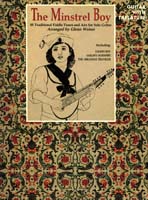 Making Arrangements Making Arrangements
By Timothy CahillIn one way at least, Glenn Weiser is up
there with the big boys. "Both Beethoven and Haydn arranged Celtic music for Scottish
publishers," the Albany musician notes.
Weiser isn't walking as close to the cliff of immodesty as it may seem.
By evoking the names of master composers, he is not so much placing himself on their level
as he is emphasizing a long tradition, that of adapting the traditional melodies of
Ireland, Scottland and Wales for a new instrument. The largely self-taught guitarist and
harmonica player has recently published the the first of a planned three-volume work
arranging Celtic airs reels, jigs and hornpipes for guitar.
The Minstrel Boy, published by Cherry Lane Music Company in
Port Chester, is a collection of 85 traditional melodies and fiddle tunes that Weiser has
translated into standard notation, for use by classical guitarists, and tablature, a
Rennaissance-old method of writing useful for fingerpicking styles. The job required more
than just listening to records and writing down the notes. For each tune, Weiser added
bass lines that give the pieces a fresh character, sweeter and more spare than you would
hear on the fiddle.
In theoretical terms, adding this second, complementary part to the
melody is called harmonizing, which is what Haydn and Beethoven did with European folk
tunes. Ans while Weiser acknowledges that the masters wrote "with greater finesse
than I ever could, he adds that thier arrangements of Celtic music weren't well recieved
by people who knew the originals, because both departed so far from tradition. One
observer compared Haydn's arrangements to a portrait that was well executed, but lacking
sufficient resemblence.
Weiser has been more mindful of the Celtic musical character, but was
also strict about conforming to classical standards of harmony. He points to a row of 23
mostly second-hand boks high up on a sagging shelf. They are the books on harmony and
counterpoint that he used to teach himself the rules followed (or established) by
composers such as Bach or Mozart. Except for a few meetings with an instructor at
Schenectady Community College after the work was nearly complete, Weiser's harmony
training is totally self-directed.
"Every time I got stuck on anything, I had to pull down every book
on harmony I had and cross-reference everything," he recalled. Eventually I attained
some level of proficiency."
Ever on the look out for hubris, the 37-year old Weiser paused on that
thought for a moment, then added seriously, "I would not want to say mastery. I'd say
proficiency. Mozart at age10 could have come up with superior harmonies."
The tunes in the book are those the arranger considers "the better
known tunes, and some of the best," of the Celtic tradition. Two other volumes delve
deeper into that tradition and include transcriptions of tunes that, in some cases, reach
back to the time medival Irish kingdoms. The project has taken ten years to complete.
The books are a passion more than a livelihood. Weiser makes some money
playing harmonica in a local blues band, but most of his living comes from teaching
stringed instruments, particularly those with fretboards, at his own Banjo and Guitar
Studio. He has written articles for the quarterly folk journal Sing Out! and
previously published a book for harmonica players.
Weiser is a man who obviously loves to pick his guitar, and readily
demonstrates a few of the tunes from The Minstrel Boy. He holds the neck of his
guitar close to his ear, classical style, and a lovely, dense weave of of sound brightens
the room. His fingers move deftly across the strings, running up and down the fetboard.
Clearly, this is not music for beginners.
"The pieces are neither rudimentary nor virtuosic," Weiser
explains professorially. The man who remembers Jimi Hendrix playing at Woodstock then
clarifies himself. "Some of the pieces are challenging," he says, "but none
of the peices is a life's work."
-from Capitol magzine, November 1989 |
 Making Arrangements
Making Arrangements Making Arrangements
Making Arrangements